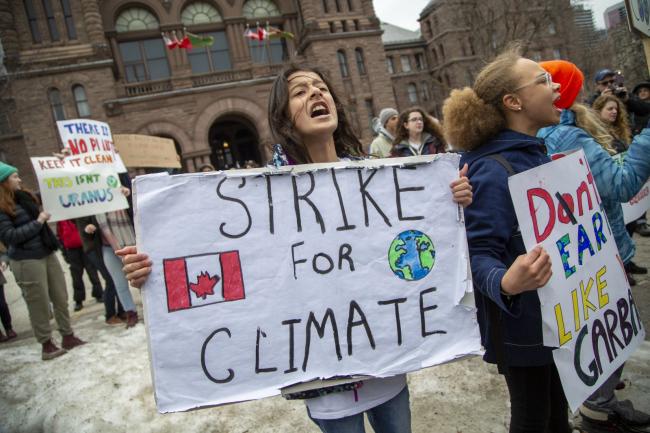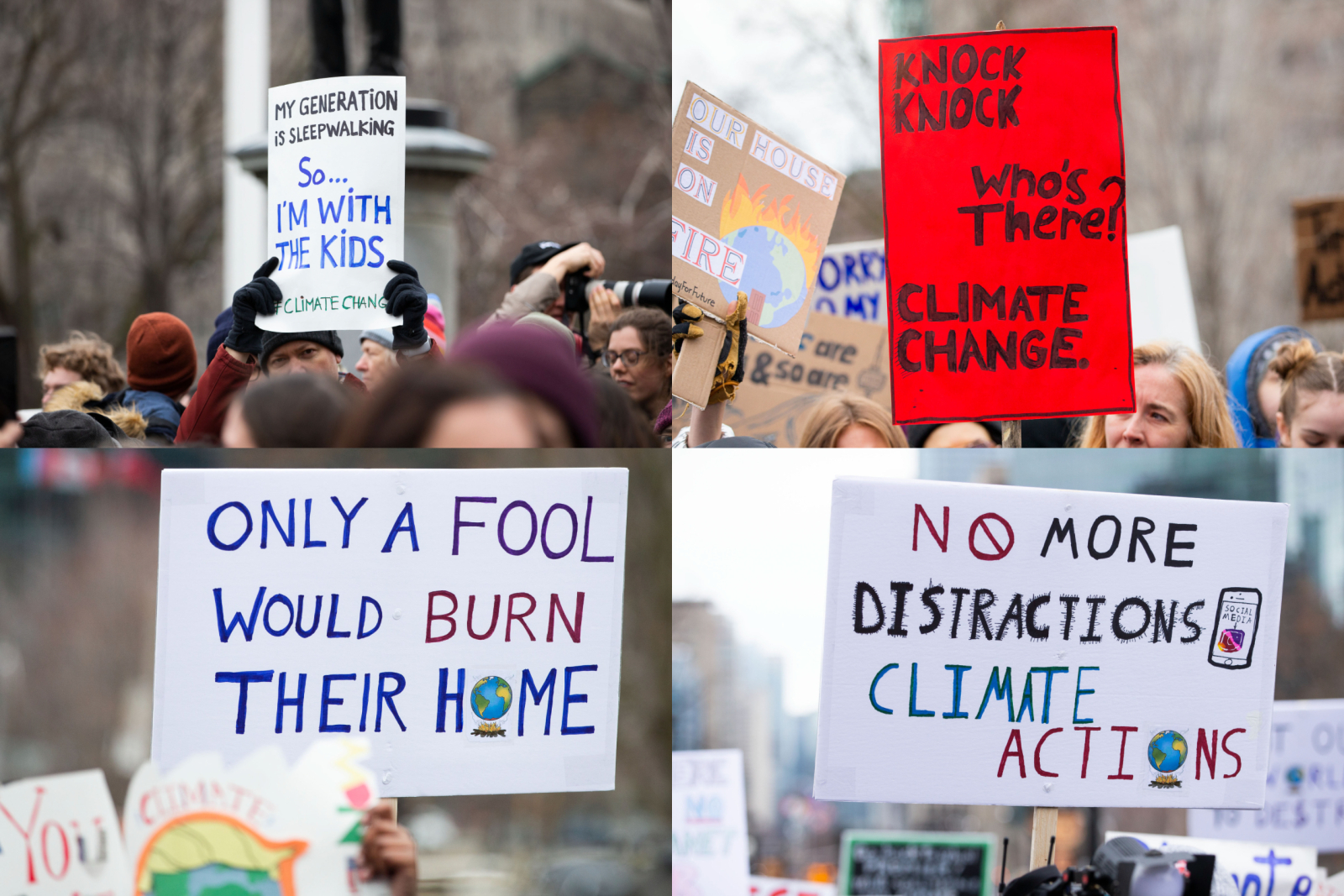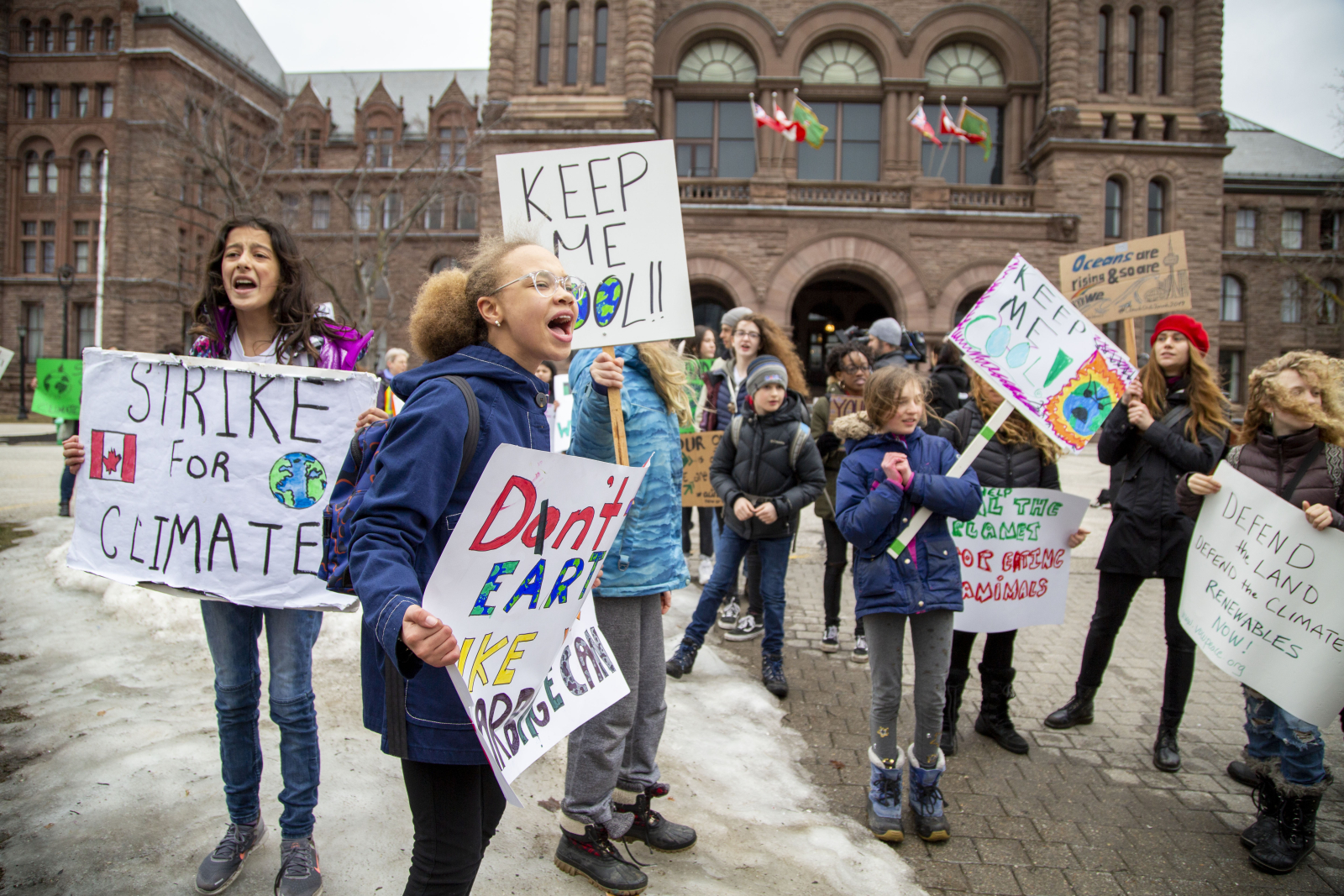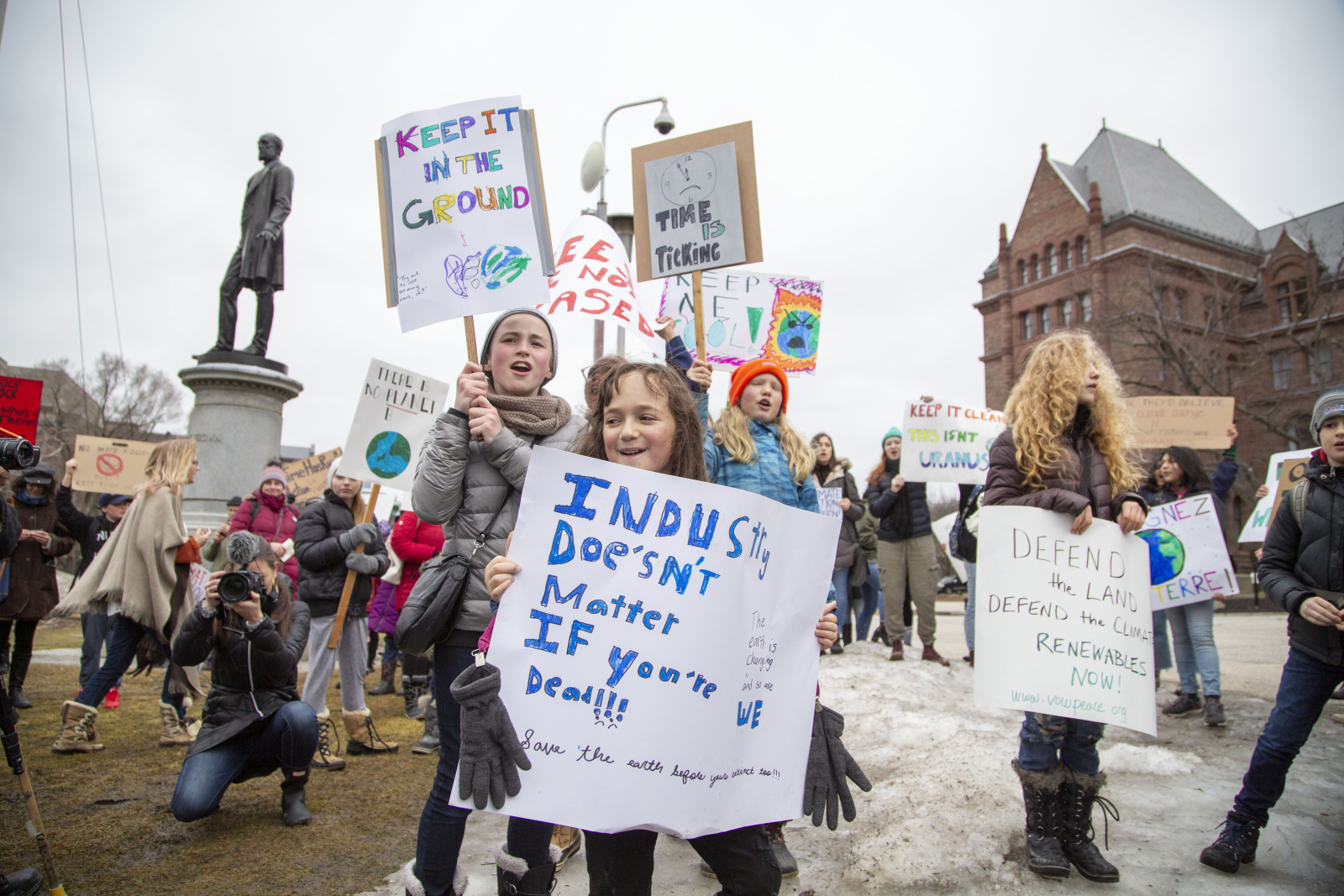Articles Menu

[Editor: complete article at link.]
Twelve-year-old Roy Bateman already knows what he’d say if he met Ontario Premier Doug Ford.
“I wouldn’t go up and scream in his face,” he says matter-of-factually. “I would ask him why he’s not taking climate action. Why he cancelled cap and trade and why he thinks this is good.”
“He just doesn’t get it. There are no jobs on a dead planet.”
Batemen was one of thousands of Canadian students striking Friday with a global call for action on climate change. They join thousands of their peers in more than 100 countries, led by the now Nobel Peace Prize-nominated Greta Thunberg.
Many of them had been preparing for weeks, doing their own research so that they could understand and speak to the rest of the population about specific topics such as carbon pricing and the UN’s recent dire warnings in a scientific assessment that said the world had less than 12 years to take action needed to avoid some of the worst impacts of climate change.
These “scary facts” have united the students, culminating in the largest gathering of young people on climate change the country has seen.
On a particularly windy Friday afternoon, students like Bateman gathered outside Ontario’s provincial legislature in Toronto to demand a better future. Their chants echoed through the air: “We are unstoppable. Another world is possible,” they roared.
“There is no planet B.”

One of the largest gatherings was in Montreal, where tens of thousands of students took to the streets in solidarity with Thunberg.
Similar events played out across the country. In Vancouver, thousands of students from municipalities across the region gathered at the Vancouver Art Gallery before making their way to the offices of Environment and Climate Change Canada.
“We really can’t dream about the future without first addressing the climate crisis,” grade 11 student Rebecca Hamilton told National Observer in an interview on Wednesday. Hamilton is a founding member of Sustainabiliteens, the group behind the school strike in Vancouver.
“The climate crisis isn’t something that’s talked about enough in our normal lives, so it can feel so isolating. Connecting with people across the world has been really empowering.”
Students at the University of British Columbia also walked out of their own classes and joined the high school students downtown.
“We recognize that the effects of climate change are felt disproportionately,” said Mukta Chachra, a first-year human geography student and a member of UBCC350, a campus-based climate advocacy group. “It’s the more marginalized communities who face the effects with the utmost severity. We want to create a just and liveable world for all.”
Chachra is from Delhi, India, where she has experienced the impacts of climate change first hand, witnessing extreme pollution. Canadians, on the other, live in relative comfort, away from the most severe impacts of climate change, she says.
“We need to realize that these struggles are real, and we need to center ourselves around leaders who come from marginalized communities.”

Students of all ages and their supporters marched to the offices of Environment and Climate Change Canada in Vancouver on March 15, 2018, demanding climate policies. Photo by Brenna Owen
According to Aliénor Rougeot, that means listening to young people too.
Rougeot is a second-year economics and public policy student at the University of Toronto who has been helping young children build the “Fridays for Future” movement.
“We are the ones who are born under the threat of climate change. We’re the first generation who has always been living under this threat,” she said.
Rougeot grew up in the the countryside in France and began her fight for a future by rallying first against the threats to the ozone layer. Now, she’s battling climate change.
“I’m afraid,” she said. “I once spoke to a young child and asked him why he was protesting. He looked at me and said ‘I want a future.’ In my head it was a ‘duh’ moment, but why don’t our governments get it?”
Swedish teenager Greta Thunberg set the school strikes in motion in August 2018. She made international headlines when she opted to sit outside Sweden’s legislature every day during school hours until after the Swedish general election three weeks later. She wrote a piece called “Sweden is not a Role Model” and called on the government to reduce emissions in accordance with the Paris Agreement.
After the election, Thunberg continued to strike every Friday, and the hashtags #climatestrike and #FridaysforFuture spread quickly on social media. Earlier this week, she was nominated for a Nobel Peace Prize.
According to http://350.org we have already passed way over one million students on school strike today.
Over 2000 places in 125 countries on all continents.
And we have only just started! #fridaysforfuture #schoolstrike4climate
(picture from Prague, Czech Republic)
The students spoke with Heyman about the CleanBC plan, which charts a path to achieve the province’s legislated climate targets of 40 per cent greenhouse gas (GHG) emissions reduction by 2030, 60 per cent by 2040, and 80 per cent based on 2050, based on 2007 levels.
“I’m inspired by the concern and commitment of all the students who have been striking to highlight the huge impacts climate change will have on their future,” said Heyman in an email his spokesperson sent to National Observer.
“Here in B.C. we’ve seen unprecedented wildfires and floods that hurt people, communities, and businesses,” Heyman continued. “What the student climate leaders who came to my office told me was ‘the time for talk has passed. It’s time to take action.’ I couldn’t agree more.”

Students of all ages and their supporters marched to the offices of Environment and Climate Change Canada in Vancouver on March 15, 2018, demanding climate policies. Photo by Brenna Owen
Federal Environment and Climate Change Minister Catherine McKenna also praised the students for “marching for a sustainable future.”
“I am motivated by their passion and I encourage students to continue taking action,” she wrote on Twitter. “They know climate change is real, and that the cost of inaction is enormous.”
NDP deputy leader and environment critic, Alexandre Boulerice, responded to the minister with skepticism.
“You know that if you listen to them, they don’t want you to buy a #pipeline,” he wrote, referring to the government’s decision to purchase the Trans Mountain pipeline system. “You know that?”
Quebec Premier François Legault also recognized the importance of the demonstration.
“I salute the commitment of youth demonstrating today so that their environmental message is heard,” said Legault in a message posted on Twitter. “We will be a pragmatic government with regards to the environment. We want concrete results. No more words, we must act. And we will act!”
One day earlier, Legault’s government announced that it was investing $10.7 million on a consortium of partners that do research on climate change impacts in Quebec, to help society better plan for the future.
Many of the kids gathered in Toronto with their parents and teachers told National Observer that there was a turning point in the urgency for them to act when a special report from the Intergovernmental Panel on Climate Change (IPCC) was released last October and showed that limiting temperature increases to 1.5 degrees Celsius above pre-industrial levels would help mitigate the most catastrophic and irreversible impacts of climate change. The report charts a path to contain global warming at 1.5 C, which requires rapid transitions in global energy consumption, transportation, and land and infrastructure management on an unprecedented scale.
“My son is 12,” Roy Bateman’s mother, Tania Gill, said. “We have a chance, a short window of opportunity to make the world better for him. I have to do everything I can.”
“These kids are asking for their futures. They know exactly what they’re talking about and its entirely rational,” Gill said. “They don’t have the jobs to change things but they can speak up.”
“This is the most galvanizing force out there.”

“Our kids deserve better,” McKenna, the federal minister, told National Observer in an email. “Climate change is real, and we need to be taking more action, not less. We will continue to work with Canadians to ensure a cleaner, more prosperous future for our kids and our grandkids.”
Canada is committed under the Paris Agreement to cutting GHG emissions by 30 per cent below 2005 levels by 2030. To meet this target, Canada cannot produce more than 513 million tons of carbon dioxide and equivalent emissions (CO2 eq).
However, in January, National Observer reported that the gap between Canada’s proposed actions and the Paris Agreement target has grown even wider in the last year, according to the government’s own 2018 annual report on emissions projections. The federal government and several provinces, including Ontario, Saskatchewan and New Brunswick are at an impasse on how to tackle climate change, fighting in court about the upcoming carbon pricing program.
If the October federal election was held 14 days later, Sara Escallon-Sotolmayor, a grade 11 Toronto high school student, would have been able to vote for the leader best suited to give her a future, she says.
“I have no voice politically in issues so I want to make my voice heard publicly,” she says. “Governments are scared of us because there is so much weight in young people protesting.”
Hamilton hopes today’s strikes will build momentum for an even busier spring. Vancouver’s Sustainabiliteens is hosting a training this weekend and plans to coordinate in-school strikes every Friday. That means students stay in class and work to raise awareness about climate change while at school.

Across Canada, students are planning an even bigger day of action on May 3. Although many students are still too young to vote, they plan to roll out a campaign that encourages adults to vote with climate change in mind this October, Hamilton said.
“We want every party to have a science-based plan to reduce emissions at the timescale the IPCC tells us we need to,” Hamilton said.
Escallon-Sotolmayor just wants to tell Canada’s leaders to “wake up.”
“I don’t know what else to say,” she said. “The science has been done. We know what’s going to happen if we don’t act on climate change.”
“It’s not a death sentence if they just act.”